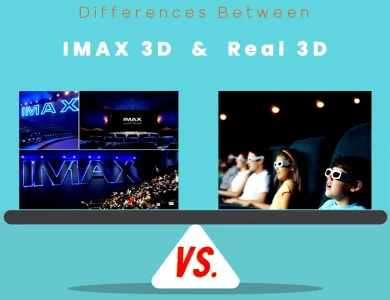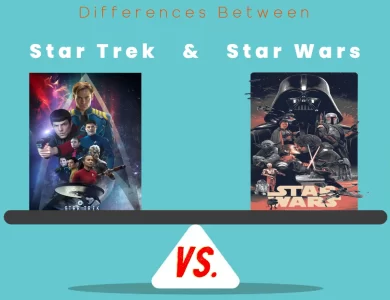Movie
Explore the Fascinating Differences in Terms and Other Items in Movies
Welcome to our comprehensive category page that delves into the captivating world of differences in terms and other items in movies! If you’re a movie enthusiast or simply curious about the intricacies that shape the film industry, you’re in for a treat. In this engaging collection of content, we explore a wide range of topics related to the various elements that make movies unique and distinct from one another.
-

Real 3D vs IMAX 3D
Are you ready to dive into the exhilarating world of 3D cinema? The choice between IMAX 3D and Real 3D can significantly impact your movie-watching experience. IMAX 3D, known for its cutting-edge technology and larger-than-life screens, offers an immersive visual extravaganza. It employs dual projectors and high-resolution imagery to deliver breathtaking visuals, making it a favorite for action-packed blockbusters and nature documentaries. On the other hand, Real 3D, found in traditional cinemas, uses a single digital projector and standard screens. While it may not match the grandeur of IMAX, it provides an enjoyable 3D experience across a wide range of movie genres. Price-conscious viewers may appreciate Real 3D's budget-friendly ticket prices, while those seeking an immersive cinematic adventure might opt for IMAX 3D's premium experience. The choice ultimately boils down to your cinematic preferences, from the type of films you love to the level of comfort and affordability you seek. In our detailed exploration of these two 3D formats, we'll uncover the critical differences that will help you decide which one suits your movie night needs. So, whether you're a fan of action-packed blockbusters or diverse movie genres, join us on this journey to make an informed choice between IMAX 3D and Real 3D for your next trip to the movies.
-

BRrip vs BDrip
When it comes to digital video formats, BDrip and BRrip are two terms that often perplex movie enthusiasts. Both originate from Blu-ray sources, but they differ significantly in terms of video quality, compression, and file size. Understanding the disparities between BDrip and BRrip can greatly impact your movie-watching experience and help you make an informed choice. BDrip, short for Blu-ray Disc Rip, is synonymous with exceptional video and audio quality. It aims to replicate the high fidelity of the original Blu-ray disc by using minimal compression. This makes BDrip the preferred choice for cinephiles seeking a cinematic experience at home. On the other hand, BRrip, or Blu-ray Rip, employs more aggressive compression techniques to reduce file size. While it sacrifices some quality, BRrip caters to users with limited storage or slower internet connections, offering a practical solution for quicker downloads and efficient storage utilization. In this comprehensive guide, we delve into the nuances of BDrip and BRrip, covering aspects such as video and audio quality, compatibility, legal considerations, and which format suits your specific needs. Whether you prioritize top-notch quality or efficient file management, understanding the differences between BDrip and BRrip is the key to enhancing your digital movie experience.
-

Star Wars vs Star Trek
Embarking on a cosmic journey through the realms of science fiction, we find ourselves faced with a delightful quandary: the timeless debate of "Star Trek" versus "Star Wars." These two iconic franchises have captured the hearts of fans spanning galaxies, igniting passionate discussions across starlit gatherings and digital spaces alike. As we delve into the vast expanse of differences that distinguish these titans of storytelling, prepare to immerse yourself in a universe of semantic nuances and captivating contrasts. From the optimistic corridors of starships to the far reaches of a galaxy in turmoil, "Star Trek" and "Star Wars" offer divergent philosophical lenses through which to view the cosmos. The former entices with the promise of exploration, diplomacy, and scientific curiosity, painting a utopian vision of a united future. Meanwhile, the latter ensnares our imagination with epic battles of light and dark, with the intricate dance between Jedi and Sith fueling a narrative of heroic struggles. As we traverse the intricacies of technology, characters, and storytelling formats, you're invited to navigate these celestial realms and forge your cosmic preference.
-

Buster Keaton vs Charlie Chaplin
Delving into the world of silent film comedy, one encounters two luminaries who shaped the genre's landscape in distinct ways – Charlie Chaplin and Buster Keaton. These legendary figures, born in different eras yet eternally etched in entertainment history, brought their unparalleled comedic brilliance to the silver screen. Charlie Chaplin, with his iconic Tramp character, wove sentimentality and social commentary into his narrative-driven comedy. The graceful movements, expressive face, and poignant messages of his films like "City Lights" and "Modern Times" showcased his unique style that touched hearts worldwide. In contrast, Buster Keaton, celebrated as "The Great Stone Face," captured audiences with his deadpan expression and jaw-dropping stunts. His approach was a symphony of visual wit and daring athleticism, evident in masterpieces like "The General" and "Sherlock Jr." Keaton's innovative use of props, intricate physical gags, and technical ingenuity carved a niche for himself as a pioneer of physical comedy.
-

Avatar vs Titanic
"Titanic" and "Avatar" stand as two iconic films that have shaped the cinematic landscape in their own remarkable ways. While "Titanic" immerses us in the tragedy and romance of the RMS Titanic's ill-fated voyage in 1912, "Avatar" whisks us away to the lush and alien landscapes of Pandora in 2154. The differences between these cinematic masterpieces extend beyond mere visuals. "Titanic" dives into themes of love, class divides, and historical accuracy, while "Avatar" delves into environmentalism, technological innovation, and the intricate interplay between humans and alien civilizations. As you navigate these two distinct narratives, you'll find yourself captivated by the contrast in genres, settings, and underlying messages that make "Titanic" and "Avatar" unforgettable cinematic experiences. Whether you're drawn to the emotional resonance of historical romance or the immersive wonders of science fiction, both films offer a journey that transcends the screen, leaving an indelible mark on the realm of storytelling.



